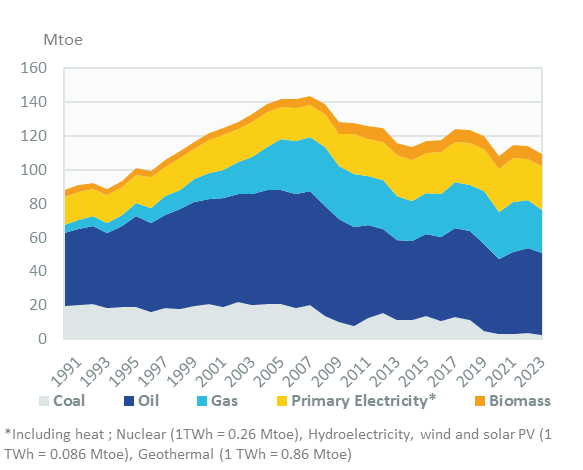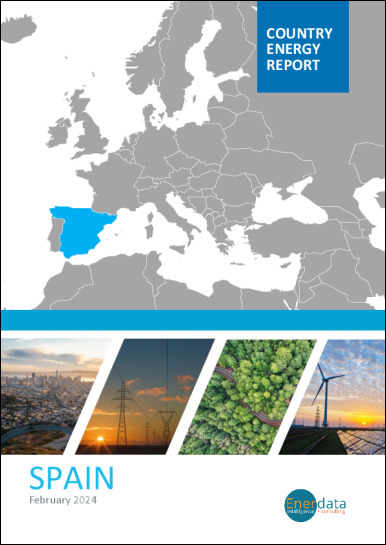- Update
-
- Format
- 4 files (PDF report, 3 Excel files)
- Pages
-
53 (Report only)
- Delivery
- Immediate by e-mail
- GENERAL OVERVIEW
- INSTITUTIONS AND ENERGY POLICY
- ENERGY COMPANIES
- ENERGY SUPPLY
- ENERGY PRICES
- ENERGY CONSUMPTION
- ISSUES AND PROSPECTS
- DATA TABLES
- ABBREVIATIONS
- GLOSSARY
Buy Spain energy report
Price without VAT. Depending on your statute and location, VAT might be applicable. Get in touch with us for more information.
After validation, you will immediately receive 4 files by email (one pdf report and 3 excel files containing the datasets).
Overview
This analysis includes a comprehensive Spain energy market report and updated datasets. It is derived from the most recent key economic indicators, supply and demand factors, oil and gas pricing trends and major energy issues and developments surrounding the energy industry. The report provides a complete picture of the country situation, dynamics, current issues and future prospects. With market data and continuous follow-up of markets news, this report brings clear and concise insights with which to tackle national energy challenges and opportunities. Browse the tabs below for a detailed table of contents, the list of graphs and tables, and details on the data files.
Highlights
- Spain targets a 48% share of renewables in final energy consumption and a 32% reduction in GHG emissions in 2030.
- The country aims for carbon neutrality in 2050.
- Coal power generation will be phased out in 2026.
- Iberdrola, Endesa, and Naturgy account for half of total power generation.
- Naturgy is the largest gas supplier. Repsol and Cepsa share the oil market.
- The share of CO2-free generation reached 75% of the power mix in 2024 (+22 points since 2010).
- Energy prices declined in 2023 and 2024, after large increases in 2022.
- Energy consumption has increased by 1%/year since 2021.
- Carbon-free sources add up to 24% of the energy mix.
- The country expects to more than double its solar and wind capacity by 2030 (to 76 and 62 GW, respectively).
- Many renewable hydrogen production and pipeline projects are under development.
Institutions & Energy Policy
The Ministry of Ecological Transition and Demographical Challenge (MITECO) coordinates the energy policy through the State Secretariat for Energy. It also covers the environmental and climate policy. An Inter-Ministerial Commission on Climate Change and Ecological Transition attached to MITECO was created in 2018 to coordinate decision-making related to climate change and energy.
Energy Companies
Electricity:
Together, the 3 largest companies accounted for 50% of Spain's total capacity and power generation in 2024.
Energy Supply
Resources:
Spain has limited oil reserves (20 Mt) and no gas reserves (3.2 bcm) (end of 2023). Shale gas reserves have been estimated at about 1 339 bcm, which would represent at least 39 years of domestic gas demand. This estimate is not associated with any geological formation but is extrapolated from the US shale gas resource characteristics of Spanish geological basins.
Energy Prices
Oil:
In 2024, the prices of gasoline and diesel oil decreased by around 5%, continuing with the trend started last year (-10%). The prices surged in 2021 (16%) and peaked in 2022 (+29% for gasoline and +44% for diesel), following international trends. Taxes accounted for 47% of the gasoline price and 43% of the diesel price in 2024.
Graph: GASOLINE & DIESEL PRICES (€/l)
Energy Consumption
In 2024, total consumption per capita was 2.3 toe, including 4 700 kWh of electricity.
Graph: CONSUMPTION TRENDS BY ENERGY SOURCE (Mtoe)

Issues & Prospects
According to the baseline scenario presented in the draft updated NECP, final energy consumption should reach 70 Mtoe in 2030.
- GRAPH 1: CO2-energy emissions (MtCO2)
- GRAPH 2: Installed electric capacity by source (2024, %)
- GRAPH 3: Gross power production by source (TWh)
- GRAPH 4: Power generation by source (2024, %)
- GRAPH 5: Gasoline & diesel prices (€/l)
- GRAPH 6: Electricity prices for industry and households (€c/kWh)
- GRAPH 7: Gas prices for industry and households (€c/kWh GCV)
- GRAPH 8: Consumption trends by energy source (Mtoe)
- GRAPH 9: Total consumption market share by energy (2024, %)
- GRAPH 10: Final consumption market share by sector (2024, %)
- GRAPH 11: Oil consumption (Mt)
- GRAPH 12: Oil consumption breakdown by sector (2024, %)
- GRAPH 13: Electricity consumption (TWh)
- GRAPH 14: Electricity consumption breakdown by sector (2024, %)
- GRAPH 15: Natural gas consumption (bcm)
- GRAPH 16: Gas consumption breakdown by sector (2024, %)
- GRAPH 17: Coal consumption (Mt)
- GRAPH 18: Coal consumption breakdown by sector (2024, %)
- Economic Indicators: Annual historical data including population, GDP growth, imports and exports, inflation rate, energy security and efficiency indicators, CO2 emissions.
- Supply Indicators: Historical data including oil and gas reserves, electric and refining capacity, energy production, power production and external trade. All are detailed by energy source.
- Demand Indicators: Historical data including consumption per inhabitant, consumption trends, total consumption by energy source, final consumption by energy source and sector, and electricity consumption by sector.
- Energy Balances: Single table displaying the overall energy industry balance per annum, also graphically displayed by energy sub-segment.
- Infrastructure Projects: Covers power plant projects by energy, technology, status and operator, gas plant projects by status and operator and LNG contracts.
The Spain energy market data since 1990 and up to
is included in the Excel file accompanying the Spain country report.
It showcases the historical evolution, allowing users to easily work with the data.
Key Data included in the excelsheet:
- Economic indicators: Annual historical economic indicators, energy security, energy efficiency and CO2 emissions.
- Supply indicators: Annual historical reserves, capacity, production and external trade (imports(+) exports(-) balance).
- Demand indicators: Annual historical consumption per capita, consumption trends, total consumption, final consumption (per energy and per sector) and electricity consumption total and per sector.
- Energy Balance: total and per energy.
- Spain Energy Prices: In addition to the analysis provided on the report we also provided a data set which includes historical details on the Spain energy prices for the follow items: price of premium gasoline (taxes incl.), price of diesel (taxes incl.), price of electricity in industry (taxes incl.), price of electricity for households (taxes incl.), price of natural gas in industry (taxes incl.), prices of natural gas for households (taxes incl.), spot price of Brent and CO2 emissions (from fuel combustion).
The Spain country dashboards are complemented with country forecasts from EnerFuture (excel file) with scenario comparison.
Data included in the excelsheet:
- Demand: Primary energy consumption, final energy consumption, by fuel, by sector.
- Power: Electricity generation & capacities, by technology.
- CO2: Total CO2 emissions.
- Macro-economy: Main macro-economic assumptions.
- Key indicators: Energy intensity, share of renewables, CO2 emissions per capita and per unit of GDP.
 Energy and Climate Databases
Energy and Climate Databases Market Analysis
Market Analysis